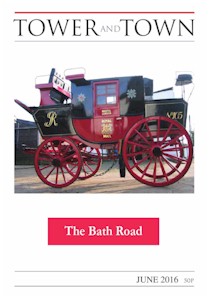

Tower and Town, June 2016 (view the full edition) (view the full edition)Royal Mail And The Great Bath RoadThe Royal Mail as the King's messengers goes back to 1516 when Henry VIII established the 'Master of the Posts', renamed the 'Postmaster General’ in 1710. Charles I opened it to the public in 1635, payment being by the recipient of the letter. By the eighteenth century it took the form of postboys on horseback carrying mail in satchels to and from London and across country (the 'bye mails'), a little like the later American Pony Express. But the system did not work very well. The riders were inclined to be waylaid and robbed and they were slow and unreliable. John Palmer was a theatre manager in Bath and Bristol with influential connections to William Pitt. He recognised the shortcomings of the postboy system and the improvements in the stage coach service, and in 1784 got permission to send the Bristol to London mail by coach on a nine day trial. There were many advantages: an armed guard could deter robbery: in case of difficulty with the coach or the team the guard could take the mail on alone with one of the horses, leaving the driver and the passengers to fend for themselves; the coach could carry more mail than a man on a pony. Although the Post Office massively opposed the experiment and filled three volumes with objections, the trial proved a resounding success and was extended. The next year mail coaches were running from London to other destinations. Initially the mail coaches were very like regular stage coaches, but in the smart Post Office livery of maroon and black and bearing the royal cypher. Quickly the patented mail coach grew distinct and settled to the pattern they kept for 50 years to the end of the mail coach era. Rather like modern contract hired cars and trucks, they remained the property of the builder (Besant and Vidler) who maintained them and charged the Post Office for their use by the mile. The Post Office provided the guard who kept the timesheet and was effectively the vehicle commander. The contractor provided the driver ('the artist'), horsed the coach at the inns along the route, and collected three pence a mile from the Post Office and the fares of the inside passengers. Unlike other stage coaches there were no seats on the roof, though one passenger could sit on the box by the driver. Royal Mail coaches ran overnight and on a very exacting schedule. They would leave London a little after 6pm and arrive in Bath and Bristol for an early breakfast. The thought of trotting through a dark moonless night with only oil lamps sounds pretty daunting, but I am assured by Mr J A E Richards (past President of the Coaching Society) who has done it, that with a grey as the nearside 'leader' (the front horses of a four horse team; the rear two horses were 'wheelers'), coach lamps and the sparks from the horseshoes on the road metal, it is quite practical. As the Great Western Railway was built out from London the mail coach would be run up onto a flat bed truck for that bit of the journey, but as soon as the railway reached Bath and Bristol, that was the end of the horse drawn service, and the end of Marlborough's direct connection with the metropolis. Alexander Kirk Wilson |